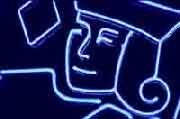Magnificent Maps (at the British Library)
Maps bring communities together. We'd be lost without them. But the latest exhibition at the British Library isn't so much a display of maps as the opening of an art gallery. These are historic maps, fantastical maps, beautiful maps - their main intention to impress rather than to inform. The earliest maps here are Roman, one tiled, the other an intricately etched plan of the seat of empire. Various medieval maps depict the world as it was imagined, the continents loose and sprawling in unfamiliar guises. The top of the map's not always north, oh no, that's merely non-progressive thinking.
Two contemporary maps challenge everyday convention. Creative artist Grayson Perry has devised his own modern take on Hereford's Mappa Mundi, with 21st century iconography amidst the retro-styled borders. His "Map of Nowhere" positions jargon in place of town names, while a faux anatomical inset shows the creator's testicles labelled "beer" and "football". Highlight of the exhibition for many is Stephen Walter's 2008 satire depicting London as an island. From Carshalton Beaches to Theydon Buoys, ever square inch of his cartoon map merits closer investigation. Just as well, then, that the curators have provided a digital screenprint which can be scrutinised using a damned-clever electronic magnifying glass.
When you feel the need to conceptualise the very fabric of society, try a map. A gorgeous 3D overview of Venice reveals the city in all its post-Renaissance trading glory. The world's largest atlas stands open at a map of Belgium, shifting our continental view towards the pre-eminent hub of Brussels. And not forgetting the people's republic of Russia, boldly asserting its homogeneity through cartographical propaganda. The power of pan-global projection lies in its undoubted ability to assimilate and strengthen the communities of the planet in cultural harmony. | | Magnificent Maps (at the British Library)
Maps reflect power. And if you've got it, then geographically flaunt it. The grounds of your Norfolk estate, the formal gardens of your stately pile, even your favourite forests for indiscriminate deer-slaughtering... a map makes clear to Johnny Public that the landowner is king. And should you have the dosh to paint the coastline of your navigational chart in gold leaf, then bally well go for it.
For a supposedly British library, there are disturbingly few homegrown maps on these walls. A lot of valuable exhibition space is wasted on our European partners, as if some blinkered curator thought we might want to see the world from a Dutch or German perspective. After the umpteenth map of Florence or some other colonial desert one's attention starts to wander somewhat. Bravo then for a 1682 copperplate map of our glorious capital entitled "London Actually Survey'd". Three cheers for a splendid global poster which proclaims "Tea Revives The World". And rah-rah-rah for a crisp clear Victorian classroom map, all capitals and major rivers, which is the right and proper stuff that even our youngest modern scholars should be learning.
Once you're out of the exhibition, you'll be glad to know there's a shop. Snippets of Stephen Walter's "The Island" are available on postcards for under a quid. Regrettably the publishers appear to have zoomed in on red-leaning inner London boroughs, and anyone hoping to buy up the entire capital will be sorely disappointed. The official "Magnificent Maps" book costs £17.95 if you're a paperback cheapskate, or nearer £30 for the proper hardback. Alternatively, for the ultimate bookshelf-filler, how about purchasing a two-foot-high Earth Atlas for a mere £3700? It's a luxury limited edition, of course, and ideal for the ostentatious display of wealth. Maps reflect power. Which is, after all, the central message of this magnificent exhibition. |

